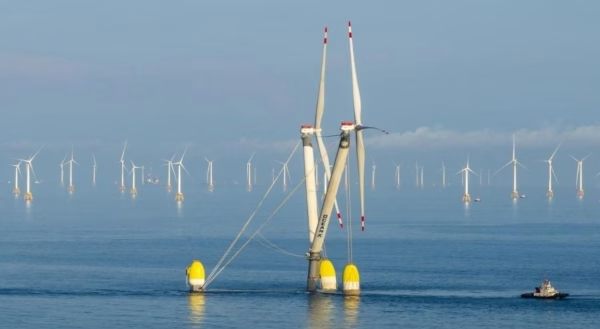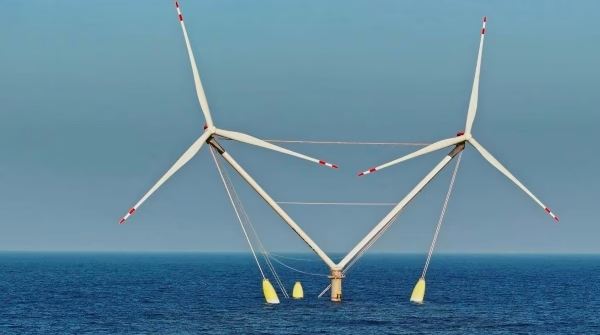China’s Mingyang Smart Energy has unveiled plans for what could become the world’s largest floating offshore wind turbine, a 50 MW-class unit, marking another advancement in the global offshore wind race. The announcement, made in October 2025, also highlights Mingyang’s push to improve turbine capacities in a bid to reduce the cost of offshore wind energy and expand deployment into deeper waters. China is also home to the world’s largest offshore wind turbine developed by Dongfang. Sany, a Chinese manufacturer also holds the record for the world’s most powerful onshore wind turbine.
Overview of the World’s Largest Floating Offshore Wind Turbine
Mingyang’s 50 MW design will feature:
- Two 25 MW rotor machines
- Rotor diameter of approx. 290 meters
- V-shaped tower design
- Hub height of approx. 190 meters
- Design water depth greater than 40 meters
- Platform displacement of about 39,000 tonnes
The floating platform design is expected to incorporate next-generation mooring and dynamic cable systems. This will improve stability and efficiency in deep-sea environments. The concept also builds on Mingyang’s MySE platform, which already includes 16 MW and 22 MW models. The latter is still undergoing certification and prototype testing off Guangdong.
Factsheet for Mingyang’s 50 MW Floating Wind Turbine
Developer: Mingyang Smart Energy Group Co., Ltd
Type: Floating offshore wind turbine
Capacity: 50 MW
Technology: MySE next-generation turbine series
Announced: October 2025
Current Status: R&D and conceptual design
Target Deployment Date: 2026 onward
Potential Implementation Sites: South China Sea

R&D and Engineering Development of the World’s Largest Floating Wind Turbine
Mingyang’s concept is currently under early-stage R&D, with feasibility studies focused on structural integrity, blade aerodynamics, and load management under extreme offshore conditions.
The turbine maker has also previously partnered with several domestic research institutes and international certification bodies to advance composite materials, digital twin technologies, and AI-based predictive maintenance systems.
While no prototype site has been confirmed, it has also been suggested that the initial deployment could occur in Chinese territorial waters. This is possibly near Guangdong or Hainan, where previous Mingyang demonstration turbines have been installed.
The 50 MW Floating Offshore Wind Turbine and its Significance to China
The turbine would double the rated capacity of the largest floating wind units currently in operation, such as GE Vernova’s 12 MW Haliade-X and Vestas’ V236-15 MW models.
The 50 MW turbine could also transform floating wind economics. The turbine would cut down balance-of-plant costs by producing more power from fewer units.
This whole project also aligns with China’s 2060 carbon-neutrality goals and the government’s target of expanding offshore wind capacity beyond 50 GW by 2030, including floating wind pilots in the South China Sea.
Market and Industry Impact
If brought to market, the Mingyang’s world’s largest 50 MW floating turbine would set a new global benchmark for offshore wind capacity. This would potentially influence design strategies and innovation for turbine manufacturers worldwide.
For developers, the 50 MW floating offshore turbine could make floating wind projects financially competitive with fixed-bottom installations within the next decade. This would mark a turning point for large-scale offshore wind deployment in countries like Japan, South Korea, the UK, Norway, and the U.S. Pacific and Atlantic coasts where activity has been ramping up.
Also noteworthy is that scaling beyond 20 MW introduces significant logistical challenges. These include blade manufacturing, transport, and floating foundation stability.
For China, this announcement reinforces its push to dominate wind technology exports. This will complement its wins in solar manufacturing and battery energy storage.
Mingyang’s MySE Platform Through the Years
2023-2024: Mingyang deploys 16 MW turbines. Also unveils 22 MW prototype.
October 2025: Announces conceptual design for 50 MW floating turbine.
2026 onward: Commercial deployment expected.

